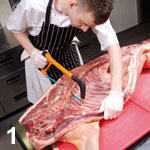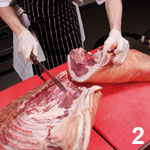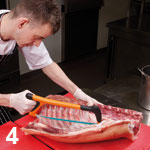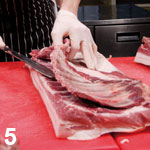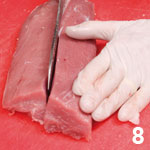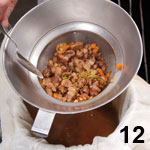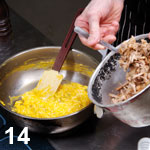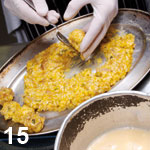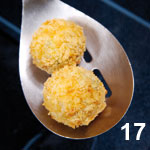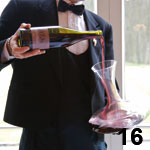Wild Boar – a masterclass
It's quite wrong to think of wild boar as an exotic meat. It's also misleading to think of reared boar as true furred game. Boar that live entirely as wild animals and are shot for sport may be young or old, large or small, tough or tender and, on occasion, almost too powerfully flavoured. Those reared for the table are recognisable as pork. They can be treated like a very-slow-grown, very large, athletic pig.
Culled at about 18 months old, they will be lean, muscular and heavy. Their free-range diet, supplemented by potatoes or cereals makes them succulent . They have a layer of hard white fat between muscle and skin. Their loins are tender, comparable to rare-breed pork. The legs will make excellent hams.
Taking the comparison with pork a step further, boar is higher in protein, lower in saturated fat and lower in cholesterol. Boar is comparable on price, too. At Lucknam Park, chef Hywel Jones pays £6 per kg when buying a whole side.
He uses the chines for the main course of his £60 three-course menu. In cooking the loins, he leaves them more underdone than he might pork. This suits the extra age in the animal. It also brings out the distinctive flavours from a foraging diet. With other cuts, he has made brawn, rillettes, terrines and sausages. The Real Boar Company, his supplier produces boar-meat salamis and hams.
Hywel Jones
Hywel Vaughan Jones, winner of the Hotel Catey Chef of the Year (less than 250 covers) in 2007, has brought an immaculate pedigree to Lucknam Park. He was formed by Nico Ladenis, first at Chez Nico, then at Nico at 90. From there he entrusted his career to Marco Pierre White. After a five-year stint at Foliage as head chef and a spell at Pharmacy, he decided to move west.
The influence of his first mentor emerges in the finesse of his sauces. And White instilled an obsessive attention to detail. His style reflects the classic London cuisine of the 1990s, tidied up, but he has added a passionate interest in his local sources of supply, always buying what's freshest and what's best.
Loin of boar, risotto fritters and spring greens
Side of Boar
- Cost: £191
Weight: 31kg - Hanging time: one week at farm plus one week in the kitchen
- Age: about 18 months
- Supplier contact: 01249 782861
www.therealboar.co.uk
Primal Cuts
Basic butchery for boar is similar to pork. Lay out the carcass with the rind underneath. Remove the shoulder. Saw through the vertebrae of the backbone in a straight line down across the third rib. Cut through the meat along this line (1).
Remove the leg. Saw through the vertebrae in a straight line where the tail connects to the backbone (look for the angle that's created there). Cut off the whole leg (2).
Seam out the kidney and kidney fat. Seam out the fillet attached to the ribs (3).
Belly and flank
The chine with the belly and flank will form a long rectangle. Estimate the approximate width of the eye muscle in the loin. At the rib end of the chine, mark a point on the rib twice the width of the eye muscle.
Saw through the ribs in a line parallel to the backbone. Cut through the meat to remove the belly and flank (4). Keeping the edge of the knife tight against the bones, remove the rib cage in a piece (use it for stock) (5).
Turn the meat over. Optionally divide it into belly and flank. Pare away the rind, leaving as much fat as possible on the joint.
Lucknam Park's pot-roasted boar
Except for the fact that the meat is cooked in a whole piece, rather than being cubed, this is basic pork rillettes recipe.
Ingredients
2kg belly or flank
30g coarse salt
4 star anise
1tsp mustard seeds
4 large garlic cloves
4 sprigs rosemary
White pepper
Method
Rub the salt into both sides of the belly. Leave it to stand overnight in the fridge with the star anise, mustard seeds, garlic, cloves, rosemary and pepper. Put it in a pan with the other ingredients. Cover and simmer very gently for four hours. The fat will render and the meat become very soft (6).
For the risotto (see below) only the chopped and flaked lean boar meat is used.
Loin and best end
Chine the loin and best end. Saw down through the vertebrae. Start at the rib-cage end, cutting across the right angle where the eye muscle slots into the bone. Take care not to saw into the meat.
With the edge of the blade against the bone, remove the bones that cover the eye muscle (not the ribs).
Pare away the rind. Separate the best end (with the ribs) from the loin.
To "French" the best end, lay the meat with the pared side facing upwards. Score a line along the rib bones, level with the end of the eye muscle. Cut through the meat and fat and remove the flank in a piece (reserve this), exposing the rib bones. Scrape around the rib bones to achieve a neat finish (7).
Seam out the loin: lay the loin with the exposed eye muscle upwards. Score a line following the eye muscle. Cut through the meat and fat and remove the flank (reserve this).
Cut away all the trimmings over the loin so it is pure, lean eye muscle, weighing about 700g.
Preparing the trimmed loin
For six to seven portions. Divide the loin into two pieces, cutting it lengthways. Split open up each piece lengthways again as though you were going to butterfly the meat (8).
Cut very thin slivers of hard bard fat from the reserved pieces of flank. Lay a band of bard fat on the split surface - it will help to baste the meat (9).
Reform each piece of loin and tie with kitchen string.
Water bath cooking of loins
Preheat the water bath to 58°C. Place each piece of loin in a vacuum bag with a clove of garlic and a sprig of fresh rosemary. Seal under vacuum (10) . Poach for 30 minutes, then blast-chill ready for service and store.
Options: best end can be muscle-boned and cooked this way, as can the fillet. The combined loin, best end and fillet would give 16-18 portions.
Wild boar sauce with sloe gin and Bramley juice
Ingredients
(Makes about 450ml sauce before finishing)
25ml pomace oil
300g lean boar in 1cm cubes
30g butter
60g onion, carrot and celery mirepoix, chopped small
1 clove garlic, half-crushed
40ml sloe gin
60ml Bramley apple juice
400ml basic brown chicken stock
Sprig of rosemary
Salt
White pepper
Method
Heat the oil in a large sauté pan until nearly smoking. Add the cubed meat so it sears on contact and in a single layer. Brown rapidly on all sides without charring and transfer to a clean pan.
Deglaze the pan in which the meat browned with butter. Before it burns, stir in the mirepoix and garlic. As soon as the vegetables soften, turn up the heat and deglaze with sloe gin and then apple juice. Add the chicken stock. Boil and then pour over the pan containing the browned boar meat (11) . Return to the boil, skimming any fat very carefully.
Simmer for no more than 30 minutes. Infuse the rosemary for the last five minutes. Pass through a chinois and muslin into a clean pan. Season and reserve (12).
Weights
Leg 9.7kg bone-in
Neck and shoulder 10.1kg, untrimmed
Fillet 780g, untrimmed
Best end 2.1kg, before trimming
Loin (muscle-boned for recipe) 700g
Belly, flank and usable trimmings 6kg approx
Waste, including rind 2kg approx
Loin of Boar, Risotto fritters and spring greens
Note the photogragh depicts a piece of lion for three servings being cooked. In a working envirnoment, the kitchen would prepare single portions (13).
Ingredients (Serves one)
110g boar loin (ex vacuum bag)
Salt
White pepper
35g butter
30g butternut squash purée
2 risotto fritters
40g boiled spring greens (sprouting broccoli, sprout tops, kale, wild garlic)
50ml wild boar sauce
10ml crème fraîche
Garnish: roasted squash cubes, pieds de mouton, caramelised shallots
Method
Take the poached loin out of its vacuum bag and pat dry. Season and portion.
Heat 15g butter in a small pan and sear the meat to caramelise the surface. Keep hot. Cut the strings and remove them.
To assemble: dab two lines of squash purée on the plate and two small blobs on which to stand the fritters.
Mix a little butter with the greens and arrange in the middle of the plate.
Slice the meat and lay it on the greens.
Boil the sauce and finish with the rest of the butter and crème fraîche. Spoon a little on the plate and serve the rest in a sauce boat.
Garnish with squash, wild mushrooms and shallots.
Risotto fritters with squash and boar rillettes
Ingredients
Makes about 16 fritters (eight servings)
80g fresh roasted butternut squash
15g maple syrup
70g butter
1tbs pomace oil
30g diced onion
100g arborio rice
300ml (approx) white chicken stock
115g flaked pot-roasted boar
Squeeze of lemon juice
Salt
White pepper
1tbs shredded sage leaves
1tbs crème fraîche
1tbs Parmigiano Reggiano
Flour, egg wash and Panko breadcrumbs
Frying oil
Method
Blend the roasted squash with maple syrup and 25g butter to form a light purée.
Heat 25g butter and pomace oil in a saucepan and sweat the onions. Add the rice and coat well. Add a third of the stock and boil until absorbed. Add the second third of stock and repeat. Add the rest of the stock and repeat to make a risotto base that should be almost cooked out and ready to serve. Stir in the squash purée. Check that the rice is done. Stir in the flaked boar meat (14).
Add a squeeze of lemon and season lightly. Heat the rest of the butter till it starts to turn noisette and stir the in sage. Mix the sage and butter with the risotto and finish with crème fraîche and Parmesan.
Blast chill the risotto. Form into walnut-sized balls (15). Roll in flour, dip in egg-wash and coat in panko crumbs. Deep-fry at 190°C (17).
Wines
Lucknam Park sommelier Christophe Pelaud suggests four very different styles of wine to accompany Hywel Jones's boar (16):
- Château Cheval Blanc 1970 Grand Classic 1st growth St Emilion
"The French tradition of a noble wine for a noble meat" - Volnay Santenot, Robert Ampeau 1978
"More delicate and fragrant with notes of sous bois" - Parusso Barolo, "Bussia" Vigna Rocche 2000 "Spicy nebbiolo with truffle aromas"
- Clos Centeilles, Minervois La Livinière 2000 from Daniel Domergue
"Equal parts of Mourvèdre, Syrah and Grenache. Roundness… freshness… elegance"



